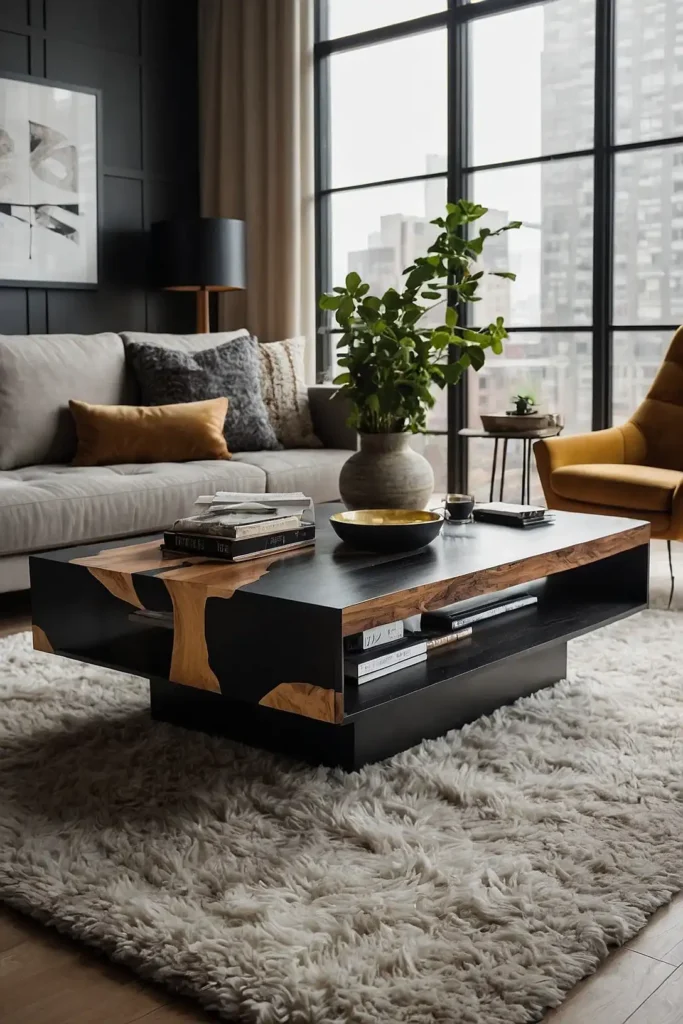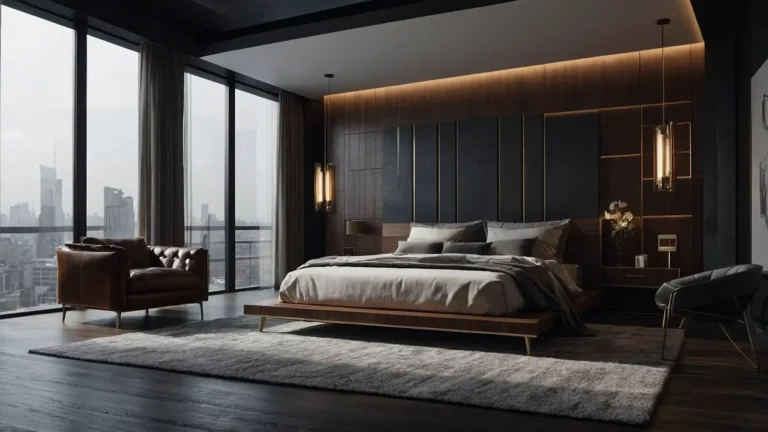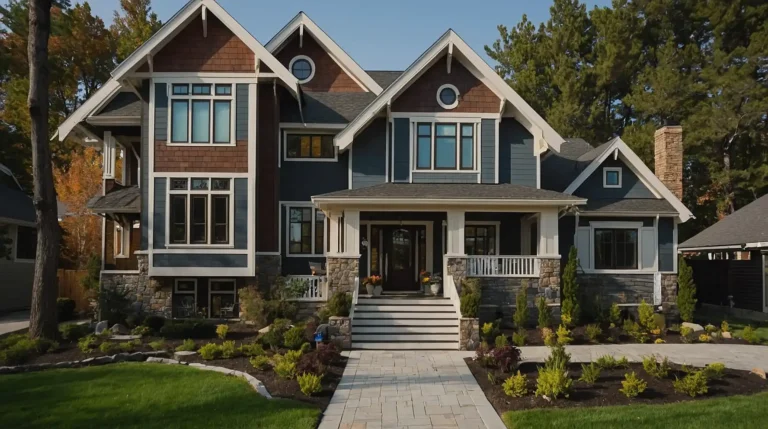21 Stunning Modern Living Room Ideas to Transform Your Space
Modern living rooms blend simplicity, functionality, and style to create spaces that feel both contemporary and timeless.
These versatile gathering places serve as the heart of your home while showcasing your personal aesthetic through clean lines and thoughtful design.
With these innovative ideas, you can transform your living room into a sleek, comfortable space that balances cutting-edge trends with practical livability.
1: Minimalist Sectional Seating

Anchor your space with a low-profile sectional sofa in a neutral tone that provides ample seating without visual heaviness.
Choose clean lines and minimal tufting to maintain the streamlined aesthetic essential to modern design principles.
Add textural contrast through accent pillows in complementary colors that can easily change with seasons or your evolving style preferences.
2: Statement Lighting Fixture

Install an architectural lighting piece that serves as functional illumination and sculptural art in your modern living room.
Select fixtures with geometric shapes, mixed metals, or unusual silhouettes that create visual interest even when not illuminated.
Position your statement light where it becomes a natural focal point—centered in the room or anchoring your primary seating arrangement.
3: Floor-to-Ceiling Windows

Maximize natural light by embracing large, unadorned windows that create a seamless connection between interior and exterior spaces.
Choose minimal window treatments like recessed blinds or simple panels that don’t compete with the clean architectural lines.
This approach not only brightens your space but also incorporates the outdoors as an ever-changing design element in your living room.
4: Mixed Material Coffee Table

Select a coffee table that combines different materials—glass with metal, wood with concrete, or marble with brass accents.
This central piece should exemplify modern design’s emphasis on material contrast while providing practical surface area for daily use.
Choose a geometric or asymmetrical shape rather than traditional rectangular or oval forms for a distinctly contemporary aesthetic.
5: Monochromatic Color Scheme

Create sophisticated visual harmony by designing around a single color utilized in various tones and textures throughout your space.
This disciplined approach maintains the clean simplicity of modern design while adding depth through subtle variations in shading.
Introduce the color through large surfaces like walls and major furniture pieces, then echo it in smaller accessories for cohesive impact.
6: Floating Media Console

Mount your television above a wall-hung media cabinet to achieve the streamlined, uncluttered look essential to modern interiors.
This floating installation creates an appealing sense of spaciousness by revealing more floor area and emphasizing horizontal lines.
Choose a unit with minimal hardware and integrated cable management to maintain the clean, technological aesthetic of contemporary design.
7: Sculptural Accent Chair

Introduce a statement chair with artistic silhouette that functions as both comfortable seating and sculptural design element.
Look for pieces with interesting forms, unexpected materials, or innovative construction techniques that showcase modern craftsmanship.
Position this eye-catching piece where it can be appreciated from multiple angles rather than pushed against a wall or corner.
8: Large-Scale Abstract Art

Hang a single oversized abstract canvas that introduces color and movement while maintaining the clean aesthetic of modern design.
Choose artwork with gestural forms, bold color blocking, or minimalist composition that complements rather than competes with your space.
Allow generous white space around the piece to create proper visual breathing room that enhances its dramatic scale and impact.
9: Integrated Smart Technology

Incorporate state-of-the-art home automation that controls lighting, sound, climate, and entertainment through seamless integrated systems.
Modern living embraces technological innovation while concealing utilitarian components that would disrupt the clean visual aesthetic.
Choose smart devices with minimal, architectural design language that enhances rather than detracts from your space’s contemporary character.
10: Mixed Seating Heights

Create dynamic spatial composition by combining various seating heights—sofa, lounge chairs, floor cushions, and bar-height stools.
This modern approach encourages different types of interaction while adding visual rhythm and functional versatility to your living area.
Maintain cohesion through consistent color palette or material selections that unify these diverse elements into a harmonious whole.
11: Geometric Pattern Play

Introduce visual energy through geometric patterns on area rugs, accent pillows, or wall coverings that add dimension without clutter.
Select patterns with clean lines and mathematical precision—hexagons, triangles, or linear arrangements—rather than organic or traditional motifs.
Limit your pattern mixing to two or three complementary designs in coordinating scales to maintain modern restraint and visual harmony.
12: Negative Space Emphasis

Embrace the modernist principle of “less is more” by deliberately incorporating empty space as an active design element in your layout.
Allow breathing room between furniture groupings, wall décor, and architectural features to highlight the intentionality of each item.
This restrained approach prevents visual noise and creates the serene, uncluttered environment that defines truly sophisticated modern living.
13: Indoor-Outdoor Flow

Create seamless transitions between interior living spaces and outdoor areas through consistent flooring, aligned doorways, and cohesive materials.
This boundary-blurring technique expands your functional living area while embodying the modern ideal of connected, flexible spaces.
Use large sliding or pocket doors that disappear completely to eliminate traditional barriers between indoor comfort and outdoor experience.
14: Architectural Concrete Elements

Incorporate exposed concrete features through floors, partial walls, or architectural details that celebrate this quintessentially modern material.
The raw, industrial character adds textural interest while its neutral tone creates a sophisticated backdrop for more refined elements.
Balance concrete’s coolness with warm woods or plush textiles to create inviting contrast within your modern material palette.
15: Layered Lighting Design

Develop a comprehensive lighting plan that combines ambient, task, and accent lighting for both functionality and atmospheric control.
Install recessed ceiling fixtures for general illumination, focused reading lamps near seating, and dramatic uplighting to highlight architectural features.
Choose fixtures with clean, architectural forms that contribute to your modern aesthetic even when not illuminated.
16: Mixed Wood Tones

Challenge traditional matching furniture sets by intentionally combining different wood finishes within a cohesive modern framework.
Select pieces with complementary undertones but distinct grain patterns and finishes to create sophisticated depth and visual interest.
Maintain modern sensibility through clean lines and simple forms that unify these diverse wood elements into a harmonious composition.
17: Floating Fireplace Installation

Install a suspended or wall-mounted fireplace that functions as both heating element and sculptural focal point in your living room.
These contemporary fire features eliminate traditional hearths and mantels in favor of sleek, architectural forms that appear to float.
Choose linear flames rather than conventional log arrangements to underscore the modern, minimalist character of your design vision.
18: Oversized Floor Mirror

Lean a large-scale mirror against your wall to create visual expansion, amplify natural light, and add architectural presence.
Select a minimal frame or frameless design with clean edges that maintains the streamlined aesthetic of modern interior design.
Position the mirror to reflect your most attractive view or architectural feature, effectively doubling its impact in your space.
19: Multi-Functional Furniture Pieces

Select innovative furniture that serves multiple purposes through transformable elements, hidden storage, or modular configurations.
This approach embodies the modern principle that form follows function while accommodating contemporary living’s need for flexibility.
Look for coffee tables that adjust to dining height, sofas with integrated storage, or modular pieces that reconfigure for different activities.
20: Vertical Garden Wall

Install a living wall of plants that brings natural elements into your modern interior while creating a dramatic architectural feature.
This biophilic design element introduces organic texture and color within a highly structured, contemporary framework.
Choose a geometric arrangement of planters and select species with architectural growth habits that complement modern design sensibilities.
21: Curved Elements in Linear Space

Introduce organic curved forms—rounded sofa, spherical pendant lights, or circular rug—to create dynamic contrast within your linear space.
These softer shapes provide visual relief from the predominantly straight lines and right angles of modern architectural design.
Limit curved elements to a few statement pieces to maintain the disciplined aesthetic while adding warmth and inviting energy.
Conclusion
Modern living room design balances aesthetic innovation with practical livability.
By incorporating these contemporary elements while honoring your personal style, you’ll create a space that feels both cutting-edge and comfortably welcoming.







